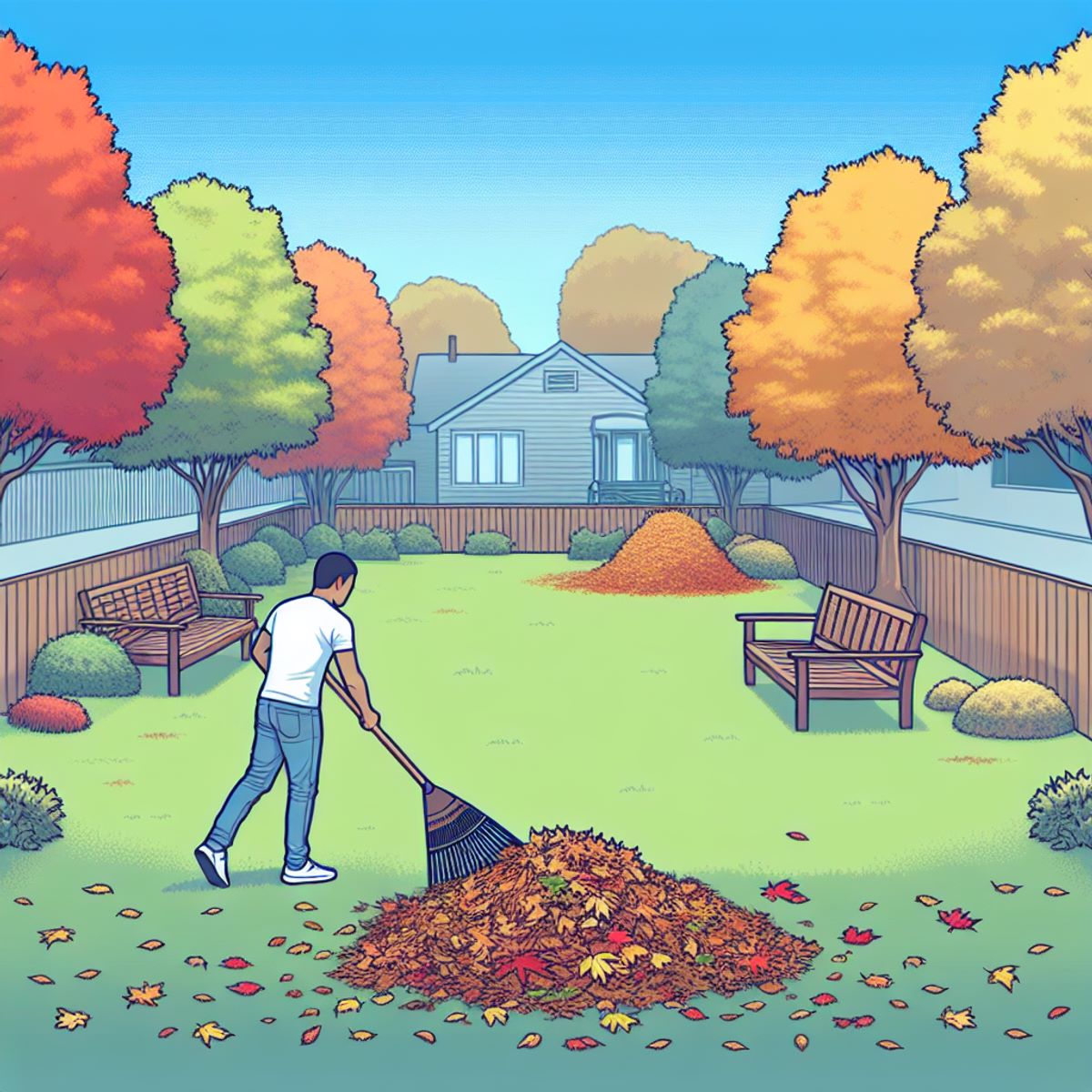Introduction
Ah, autumn. The season of pumpkin spice, cozy sweaters, and… an endless battle against the deluge of falling leaves. Sure, a yard blanketed in a mosaic of reds, oranges, and yellows can be a sight to behold. But let’s get real: those leaves aren’t going to rake themselves. And unless you’ve got a magical tree that disposes of its own foliage (we’re still waiting for science to get on that), you’re going to need the best way to rake leaves.
Raking might seem like a straightforward chore, but don’t be fooled—there’s an art to it. Striking the perfect balance between thoroughness and efficiency can transform this seasonal task from a dreaded weekend-long ordeal into a quick workout session. Who said yard work couldn’t be a breeze?
Now, what if someone told you that there existed a genius way to rake leaves that could slash your time spent in half? Intrigued? You should be. Say goodbye to random attacks on leaf piles and hello to strategic strokes that leave your lawn pristine in no time flat.
So grab your rake—or don’t just yet—we’re about to dive into some leaf-raking wisdom that will have you seeing fallen foliage in a whole new light. Let’s save time and make those trees wonder where all their leaves went!
Understanding Leaf Raking
The Significance of Leaf Raking for Maintaining a Tidy Yard
Raking might seem like a chore relegated to the realms of weekend to-do lists, but its impact on your yard’s aesthetics and health is undeniable.
Leaves left unattended create a blanket over the grass, hindering growth by blocking sunlight and air circulation. This can lead to unsightly patches in the lawn come spring. Regular raking keeps the yard looking manicured and prevents the accumulation of damp leaves which can become slippery hazards on pathways.
Impacts of Fallen Leaves on the Property and Wildlife
Property Concerns:
- Drainage Issues: A thick layer of leaves can clog storm drains and gutters, leading to water damage or ice dams in colder climates.
- Lawn Health: A build-up of leaves may encourage fungal diseases in your lawn due to excess moisture and lack of sunlight.
- Pest Haven: Piles of leaves are ideal for pests like rodents or insects, who may then find their way into your home.
Wildlife Considerations:
- While it’s true that some wildlife benefits from a layer of leaves for shelter during colder months, an excessive amount can choke out native plants essential for local ecosystems.
- Strategically leaving leaves in certain areas can provide habitats for beneficial insects and small animals while keeping your property tidy.
By understanding these perspectives on leaf raking, we can approach this task with a balance between maintaining a pristine yard and being mindful of our surroundings. Equipped with this knowledge, let’s explore choosing the right tools that make leaf raking more effective and less time-consuming.
1. Choosing the Right Tools for Leaf Raking
When autumn sheds its leafy bounty, it’s not just about grabbing any old tool from the shed; selecting the appropriate equipment can be a game-changer for your leaf-raking adventures. Here’s what to scope out:
Assess Your Leaf Blower Options

Leaf blowers are like the sports cars of yard work — fast, efficient, and a little loud. But before snagging one, ponder these factors:
- Power Source: Gas or Electric? Gas blowers pack a punch but weigh more and belt out decibels. Electric ones whisper in comparison and are lighter, but they’ll keep you on a leash (unless you go cordless).
- Ergonomics: Can you lug it around without calling it quits after ten minutes? Comfort is key.
- Capacity: Match the blower’s might to your yard’s scale — don’t bring a sledgehammer to swat a fly.
The Shovel: A Classic Reimagined
Forget the back-breaking image of shoveling; today’s ergonomic designs with curved handles and lightweight materials make leaf gathering less of a chore.
- Consider a shovel with a wide scoop to maximize each load.
- Aim for durability — high-quality plastic or metal alloys that scoff at rust.
Mulch Like You Mean It
A mulching mower might just be your unsung hero in the leaf-management saga:
- Double Duty: These mowers slice and dice leaves into fine pieces that decompose swiftly, nourishing your lawn as they go.
- Reduce Waste: By mulching leaves, you’re cutting down on bags bound for the landfill.
- Save Time: Why rake and bag when you can do a tidy mow and enrich your soil simultaneously?
Armed with these insights, you’re now primed to wield the optimal tools for turning a leaf blanket into lawn loveliness. With your arsenal ready, let’s breeze into techniques that’ll have those leaves corralled in no time.
2. Techniques for Efficient Leaf Raking
When the leaves start to turn those fabulous shades of orange and red, it’s a visual treat—until they hit the ground and become your weekend chore. But fret not, because mastering the best way to rake leaves can turn a seemingly Sisyphean task into a brisk workout with rewarding results.
Work Smarter, Not Harder
Efficiency is king when it comes to yard work. Here’s how to rake smarter:
- Create Small Piles: Instead of dragging leaves across the yard, work section by section. This minimizes effort and keeps morale high as you see clear progress.
- The Tarp Trick: Lay out a large tarp in your working area. As you make small piles, deposit them onto the tarp. When full, drag the tarp to your disposal or composting area. This is much easier on the back and arms than bagging as you go.
- Use a Leaf Scoop: These handy tools look like oversized salad tongs and allow you to pick up massive amounts of leaves at once. They’re especially useful when transferring piles onto a tarp or into bags.
Rake With The Wind
Wind can be an ally or an adversary in the battle against fallen leaves:
- Assess Wind Direction: Before starting, notice which way the wind is blowing. Raking in the same direction as the wind means less resistance and fewer leaves blowing back into your clean space.
- Shielded Spots: Use your house or other structures to create natural barriers where the wind is less likely to undo your hard work.
Timing Is Everything
It can be tempting to wait until all leaves have fallen, but here are some timely tips:
- Rake Regularly: Raking more frequently in smaller amounts can be more manageable than one Herculean effort.
- Dry Over Wet: Dry leaves are lighter and easier to handle than wet ones. Aim for a dry day shortly after a light leaf fall for optimal conditions.
The Back-and-Forth Technique
This method reduces physical strain:
- Stand upright with feet shoulder-width apart for stability.
- Hold the rake comfortably close to your body to reduce back strain.
- Use short, quick strokes alternating between pulling towards you and pushing away in a “shoeshine” motion.
- Turn frequently from side to side to engage different muscle groups and prevent fatigue.
Adaptive Strategies
No two yards are alike; adapt these strategies as needed:
- Slopes & Hills: Rake leaves downhill whenever possible—it’s easier and gravity does some of the work for you.
- Trees & Bushes: Start near these leaf-dropping culprits and work outward so that you’re not doubling back over cleaned areas.
By employing these techniques, anyone can transform their approach to raking leaves from time-consuming drudgery into an efficient operation that maximizes effort while minimizing time spent. The key lies not only in choosing suitable tools but also in adopting smart raking methods that align with nature’s patterns — like working with the wind rather than against it — ensuring that this autumnal task doesn’t become an overwhelming burden.
3. Bagging and Disposing Leaves

Once you’ve gathered your leaves into neat piles with your raking prowess, it’s time to tackle the next step: bagging and disposing of them. This isn’t just about stuffing leaves into bags willy-nilly; there’s an art to it that can save you time and energy.
Effective Bagging Techniques
Bagging leaves is more than a mere chore—it’s the final lap in the leaf-clearing race. Here are some effective methods to do it right:
- Use Reinforced Bags: Choose sturdy, reinforced bags that won’t tear when you stuff them with damp leaves.
- Leaf Scoops: Equip yourself with leaf scoops, large plastic “hands” that increase your capacity to pick up leaves and fill bags quickly.
- The Tarp Trick: Spread a large tarp on the ground and rake leaves onto it. Once full, gather the corners of the tarp and drag it to your disposal site or use it to easily tilt leaves into a bag.
- Stand-Up Bag Holders: These handy devices keep bags open and upright, making it easy to fill them without needing an extra pair of hands.
Vacuums and Mulchers
For those who prefer technological assistance, leaf vacuums and leaf mulchers offer a streamlined approach to leaf disposal:
- Leaf Vacuums: Acting as the inverse of a blower, these machines suck up leaves directly into a collection bag. They’re ideal for quick cleanups on hard surfaces or for vacuuming leaves out of shrubs and flower beds.
- Leaf Mulchers: These machines grind down leaves into fine particles. The benefits? Mulched leaves decompose faster if used in compost and take up less space in bags, meaning fewer trips to the curb or compost pile.
Some leaf vacuums come with a mulching feature, giving you a two-in-one solution for tidying up your yard efficiently. The reduction in volume achieved by mulching can significantly cut down on the number of bags used, which is convenient and eco-friendly.
Remember, whether you’re manually bagging or using high-tech equipment, efficient disposal of your foliage finds should align with local waste management regulations—some areas provide specific leaf pickup services or require biodegradable bags.
4. Tips for Safe and Easy Leaf Raking

Raking leaves can be as breezy as a fall afternoon with the right approach to safety and comfort. Here’s how to make sure you’re raking smart, not hard:
Safety First with Leaf Blower Usage
Leaf blowers are nifty, but they’re no toys. Keep these pointers in mind to steer clear of trouble:
- Read the Manual: Sounds tedious, yes, but knowing your equipment is half the battle won.
- Inspect Before You Direct: Check for damaged parts or debris before starting your leaf blower.
- Secure the Area: Ensure pets and people are at a safe distance to avoid accidents.
Protective Gear for Yard Work
Dressing for success isn’t just for boardrooms—it’s for backyards too! Suit up with:
- Gloves: They’re like a cozy hug for your hands, providing grip and protection from blisters.
- Ear Protection: Those blowers can roar louder than a lion. Earplugs or earmuffs can keep your hearing sharp.
- Eye Protection: Goggles shield your peepers from flying debris—because nobody likes dirt in their eyes.
- Dust Mask or Respirator: If you’re kicking up more than just leaves, a mask keeps the dust and allergens out of your airways.
- Sturdy Footwear: Sneakers or boots with a grip can prevent a slip-up on the leaf-laden ground.
Suiting up appropriately and handling tools with care ensures that when it’s time to move on to unique yard environments, you’re ready for anything that falls your way.
Managing Leaves in Special Yard Environments
When it comes to your backyard, each grass blade counts. A lawn’s health can be impacted positively or negatively by how you manage the fallen leaves. Here’s a scoop on what to keep in mind:
Yards with Grass and Lawns
1. Avoid Thick Layers
A carpet of leaves can smother grass, block sunlight, and inhibit growth. Make sure to clear away thick layers of leaves to keep your lawn breathing.
2. Regular Maintenance
Aerate your lawn before the leaves start falling; this will help it stay robust against the blanket of foliage.
Designated Areas for Leaves
1. Compost Piles
If you’re into composting, rejoice! Leaves are a “brown” material, rich in carbon—perfect for balancing your compost pile.
Remember: For an effective compost, mix one part green materials (like kitchen scraps) with three parts brown materials (like dry leaves).
2. Wildlife Habitats
Some critters love a good leaf pile. Designate an area of your yard to leave a mound of raked leaves. It can serve as a habitat for insects and small animals during colder months.
Quick Tips
- Mulching Mower Magic: If you have a mulching mower, use it to shred leaves on your lawn. The tiny pieces decompose quickly, nourishing your grass with nitrogen.
- Spot Checks: Keep an eye on moisture-prone areas; if left unchecked, piles of wet leaves can lead to fungal diseases in the lawn.
By tailoring your approach to the specific needs of your yard environment, you’ll ensure that both the beauty and health of your green space are maintained through all seasons.
Conclusion
Nothing beats the satisfaction of looking over a clean, leaf-free yard after a good raking session. Armed with The Genius Way to rake leaves, that satisfaction can come quicker and easier than ever before!
Consider the tips and techniques we’ve discussed:
- Choosing the right tools for efficiency
- Adopting smart raking techniques
- Bagging and disposing of leaves effectively
- Keeping safety paramount during yard work
- Managing leaves in different yard environments
These are not merely suggestions, but strategies to revolutionize your leaf-raking routine. So why not give them a try?
Efficient leaf disposal goes beyond aesthetics. It’s an essential step in maintaining a healthy environment for your lawn and local wildlife. Remember, proper management of fallen leaves can save you time, protect your property, and contribute to a more eco-friendly neighborhood.
Here’s to embracing autumn with open arms, ready to tackle those falling leaves with newfound knowledge and preparedness. And remember — every leaf raked brings us closer to the cozy charm of winter.
So get out there, grab that rake (or leaf blower), and make your yard the envy of the neighborhood!
Citation
- Taylor, G., & Bob Vila Staff. (2023, October 17). 16 Leaf-Raking Lessons No One Ever Taught You – Bob Vila. Bob Vila. Retrieved February 15, 2024, from https://www.bobvila.com/articles/rake-leaves/
- Reviewed. (n.d.). You’re raking leaves wrong—here’s how to rake leaves right in 7 steps – Reviewed. Retrieved February 15, 2024, from https://reviewed.usatoday.com/home-outdoors/features/how-to-rake-your-leaves-the-right-way
- Lawrence, C. (2022, October 9). How to rake leaves the easy way — tips and tricks. Tom’s Guide. Retrieved February 15, 2024, from https://www.tomsguide.com/how-to/how-to-rake-leaves
- Better Homes & Gardens. (n.d.). 8 Leaf-Raking Tips to Make Fall Cleanup So Much Easier. Better Homes & Gardens. Retrieved February 16, 2024, from https://www.bhg.com/gardening/yard/leaf-raking-tips/
- Condé Nast. (2023, September 20). Raking Leaves Doesn’t Have to Be Awful | Architectural Digest. Architectural Digest. https://www.architecturaldigest.com/story/raking-leaves-a-how-to-guide
FAQs(Frequently Asked Questions)
When autumn sheds its leafy bounty, it’s not just about grabbing any old rake. Consider the size of your yard, the type of leaves you’re dealing with, and your physical capabilities. Look for ergonomic handles, adjustable heights, and durable tines to make the job easier.
Leaf blowers come in various types, including gas-powered, electric, and battery-operated models. Consider the size of your yard, noise regulations in your area, and your comfort with handling different types of equipment. Research the pros and cons of each type to find the best fit for your needs.
The back-and-forth technique involves standing upright with feet shoulder-width apart and pulling the rake toward you in a backward motion. This method reduces physical strain and allows you to cover more ground without overexerting yourself.
Bagging leaves is more than just stuffing them into a sack. Use sturdy bags that won’t tear easily, fill them only about two-thirds full to avoid spills, and twist the tops tightly to prevent air from getting in. Consider using leaf scoops or a tarp to make the process easier.
Leaf blowers may seem like fun gadgets, but they require careful handling. Always wear ear protection, eye goggles, and a dust mask to shield yourself from noise and debris. Be mindful of bystanders and pets in the area, and never point the blower at people or animals.
Each yard has its unique features that require tailored leaf management strategies. For example, if you have grass and lawns, avoid letting thick layers of leaves smother the grass with regular maintenance such as aeration before the leaves start falling. Designate specific areas for compost piles or wildlife habitats to make the most of fallen leaves.
Perla Irish, who is more familiarly known as Irish, is the Content Manager at newfld.com. She loves following trends around home and garden, interior design and digital marketing. Through this blog, Irish wants to share information and help readers solve the problems they are experiencing.
